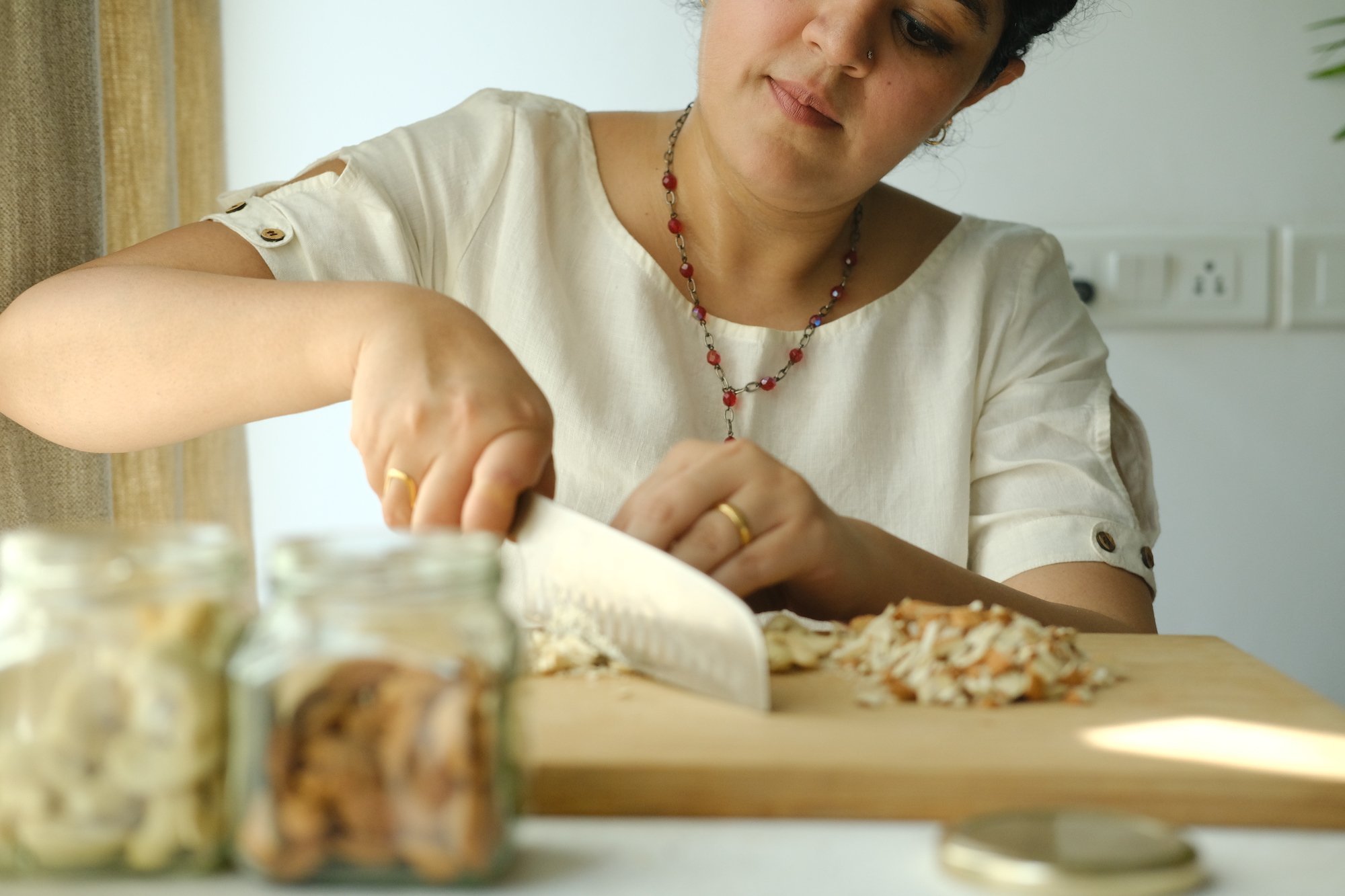An Unforgettable Recipe for Nariyal paak

Amrita Amesur makes nariyal paak, a recipe she recreated with her mother, despite her worst fears that it was lost to time. “Wonderfully dense, it had a deep-roasted coconut flavour; bold, sharp heat from black pepper, dried ginger and mace. It warmed me from the insides, and so unlike the soft yielding ghee-soaked mound that was Mysore paak. I registered the taste memory then as extraordinary.”.
This is a #1000Kitchens feature. You can read the full story here.
AMRITA AMESUR’S RECIPE FOR NARIYAL PAAK
Ingredients
2 whole coconuts (2 cups), freshly grated or scraped
10 tbsp of desi ghee
400 grams or 2 cups of regular white sugar
250 ml or 1 cup of milk
100 gm edible gum (gond or dink)
1 tbsp (30-40 whole black peppercorns)
1.5 tbsp (30-40 cloves) whole green cardamom
1 blade of mace
4-5 tbsp or about 50 grams dried ginger powder
A generous grating of nutmeg
2 tbsp poppy seeds
2 tbsp melon seeds
2 cups of cashews, almonds. Salted and roasted nuts also work.
Pinch of salt, if using unsalted nuts
Equipment needed
One large thick bottomed pot
Sturdy long handled steel spatula to stir, scrape and roast
Mixer or food processor to blend nuts, seeds, gum
A spice grinder or a mortar and pestle for pounding spices
Measuring cups and spoons
An
*Standard Measuring Cups and Spoons Used
Method
Weigh out and measure all the ingredients. Grease a 9-inch thaali (or two smaller ones) or flat dish with raised sides with ghee to set the nariyal paak.
Grind or coarsely pound the spices — black pepper, cardamom and mace — in a mortar and pestle or in a food processor. Do the same for the nuts — it should be roughly ground almond cashew powder, but not a fine paste. Add melon seeds here to blend.
In a heavy bottomed pot, heat up 5 tbsp of ghee and fry the gum until it has inflated and turned a crunchy opaque. The gum will suck in all of the ghee. Keep stirring and frying in the ghee until each crystal has fried otherwise some bits may remain raw. Add in a tablespoon more ghee in case it feels undercooked.
With a slotted spoon, remove the fried gum and decant into a food processor, mixer jar or a mortar and pestle. The idea is to process or pound down the gum to create a coarse powder. If using a blender/processor, use the pulse option to make a coarse powder, it can become pasty if over-processed. Once powdered, set it aside.
Add another 4-5 tbsp of ghee into the same heavy bottomed pot. Once warmed, add freshly ground cardamom, black pepper, mace and dry ginger powder and stir for a few seconds until aromatic.
Quickly toss in all of the grated coconut and slow roast the coconut in the spices on a medium to low heat, for about 8-10 minutes. Stir often, ensuring nothing is sticking or burning at the bottom. Keep scraping out any browning bits at the bottom of the pot, it’s all flavour.
Once the rawness and moisture of the coconut has passed substantially and as it’s starting to brown, add in the pulsed nuts and melon seeds powder, poppy seeds, the fried acacia gum and slow roast on low to medium heat stirring and roasting all the elements together.
Keep slow roasting until the coconut has lost all of its natural moisture and has turned a toasted shade of golden brown. If your nuts are unsalted, you can add in a tiny pinch of salt at this stage to enhance their nuttiness and flavour.
The whole slow roasting process should take about 45 – 60 minutes. Keep the flame on medium the whole time, while stirring often to ensure it’s all roasting evenly. It’s done roasting once the ghee starts separating from the mass and everything is golden brown and starts to become heavier when stirring.
Grate in nutmeg for aroma.
At this point you want to add in the sugar and the milk. Stir.
It’s very important to cook out all the water released from the coconut at the beginning and then the sugar and the milk later on. It should be cooked to the point of where you can no longer see the milk or any liquids otherwise the moisture can end up shortening the shelf life of the dish and may end up causing it to develop fungus.
Once all the liquid is absorbed or evaporated and the mixture is semi solid, quickly decant into the greased thaali so there’s at least about an inch of thickness to the paak.
Use the flat bottom of a measuring cup or a bowl to smoothen out the top while it’s still warm, dabbing as you go, such that it’s one even layer in the thaali.
Allow the mixture to sit a minute or so and then with a sharp knife, cut into squares. Garnish with flaked almonds or cashews and some more poppy seeds. Cool and serve.
The paak can be decanted and pieces stored in a sealed container or in the thaali itself with a lid on/plastic wrap so it doesn’t dry out. Will store in the fridge comfortably for 2-3 weeks.
ALSO ON GOYA











